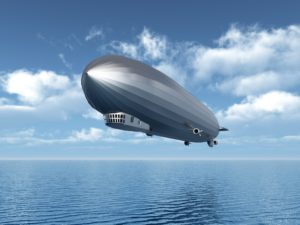Re-inventing the Airship
Brian Cartwright speaks to Gregory Gottlieb, managing director, Airships Arabia
This month I had the pleasure of interviewing Gregory Gottlieb the managing director of Airships Arabia and a leading authority in the airship sector. I have been reading a lot about this re-emerging technology especially in terms of the logistics sector, but since talking to Gregory I have realised just how much of a potential game changer this can be for a number of sectors, and its already on its way.
As of this year there are more than 10 companies working on competing designs for the airships market and Airships Arabia has already made the move to become the first airship services provider in the Middle East with the UAE registration of the company being completed at Dubai World Central in early 2016.
Realistically how far away are you from providing physical logistics using airships in the MEA region?
Well we will be initiating our application for an AOC in the coming months, but the vehicles themselves are still currently in development by companies in the USA, Russia and the UK, including Lockheed Martin and Hybrid Air Vehicles Ltd. We need to see at least one hybrid operating and at least part way through its type certification before we can assume that the technical risk is sufficiently low to give our investors confidence in our business case.
When do you imagine the testing and certification phase to be completed?
The Hybrid Air Vehicles Ltd Airlander 10 in flight is scheduled to be undergoing its initial test flying during this summer, so depending how that goes we will have a better idea of the timeframes for additional phases.
Can you briefly explain why you refer to these airships as hybrids; how do they differ from conventional airships?
We refer to them as hybrids because they combine three sources of lift. Unlike conventional airships, which just use lift from the displacement of air with lower density gas normally Helium these days Hybrids also make use of their aerodynamic shape to generate lift from motion through the air. Their size however, means that they can generate a significant amount of such lift at relatively low airspeeds. The third source of lift is derived from either vectoring of their engines or directing engine thrust up, to provide lift, or in other directions for directional thrust, as required.
Also in addition to these hybrids, Airships Arabia will operate and support conventional airships, as well as providing maintenance support to other types of lighter-than-air vehicle, such as aerostats.
What is the current focus of the business while you wait for these Hybrid Airships to be certified?
As an interim activity, the company has been engaged in providing logistics, management and aviation consulting services to clients with an interest in the future use of airships and/or hybrids. Our main focus however has been to get ourselves ready for when type certified hybrid airships become available on the market.
 What will be your initial focus for the business once the Airships arrive?
What will be your initial focus for the business once the Airships arrive?
Well our core business will be the operation, maintenance, training and support of hybrid airships across the Middle East so we have been analysing and researching markets across the region, as well as developing relationships with manufacturers and key stakeholders. We are also starting to identify regional operating partners with whom we will develop a symbiotic relationship in their home countries, while providing the technical, operational and training expertise from our home base in the UAE.
The market analysis that we are currently working on has identified a number of potential lead users in other words companies that might use the hybrid service were it available today, and would be prepared to undertake joint studies of the potential savings in both cost and time that the use of hybrids could represent for them.
Where are the main opportunities identified by your research so far?
Based on our research to date the markets we are planning to address fall broadly into three categories; logistics, surveillance, and passenger transport.
From a logistics perspective hybrids will have low operating costs as the majority of the lift is provided by Helium without the need to burn fuel to maintain that lift. In addition, although they are extremely large, for example the Airlander 10 is 93 metres long and larger than an A380, they tend to have a lower part count, a more benign operating environment and, although slower than most commercial aircraft, a very long endurance which is measured in days, rather than hours.
They also have lower maintenance overheads. We believe them to be ideally suited for bulky but lighter weight payloads, such as perishables. Flowers from Africa to the Middle East is one case study we are looking at. They are also ideally suited for the movement of specialist equipment to and from remote areas, which would certainly benefit the oil or gas sector as a prime example.
They are ideal for these types of tasks as hybrids are able to carry very large and unconventionally shaped payloads, both internally and externally. In addition, they can operate from almost any surface, including sand, grass, concrete or water and have no requirement for conventional runways.
Passenger transport is also an area of interest especially if you take industrial passengers for example where you have oil or gas workers changing shift to and from remote production sites.
Fare paying passengers would also benefit from the yacht-style environment offered in the unpressurised cabins. Tourism, charter and shorter commuter routes are all being studied at present. The Airlander 10 is planned to carry 48 passengers but future hybrids may well carry more. And we believe that the growth of tourism in the Gulf region will greatly benefit from the introduction of these vehicles.
The final category we are looking at is Surveillance. Originally conceived as military surveillance vehicles, hybrids, with their significant payload and long endurance, are ideal for both persistent surveillance tasks for military and government customers, as well as for commercial survey, broadcast TV and even aerial advertising and PR tasks.
The Airships Arabia business sounds like a very exciting proposition, but what would you say about the main challenges and obstacles you will face when introducing the concept into this region?
The challenge of introducing a fundamentally new vehicle concept into the marketplace is the main one but that was already addressed successfully more than a decade ago by the German airship developer, CargoLifter AG, which ultimately failed for financial reasons in 2002. They operated a Lead User concept that developed close and mutually beneficial relationships with potential customers from early on in the development process; Airships Arabia is planning to adopt a similar approach.
Another leaf that we are lifting from CargoLifters playbook is their understanding of the three phases of market entry.
First, we will undertake tasks that could be done by other means today, but for which hybrids can either save time or cost, or both.
Secondly we will enable tasks to be undertaken that cannot easily be done by existing means, such as the carriage of items that are too large in one or more dimension to be carried by train, truck or aircraft, thereby influencing product design to become more efficient.
The third and final stage is when we begin to influence the way in which our customers businesses are operated, by allowing them to, for example, centralize the maintenance of heavy equipment that traditionally had to be maintained on distributed sites due to the challenge of moving those items by conventional means.
Finally, what are the advantages and disadvantages in terms of cost, payload and speed of Airships as a cargo carrier in comparison to traditional Ocean Freight and Air Cargo?
Studies undertaken in the past by CargoLifter, as well as by the US military, showed that much can be gained by using airships, and by hybrids in particular, for the carriage of certain types of goods. No airship or hybrid can match the speed of a conventional aircraft, but their airspeed is better than most cargo ships, they are not constrained by roads or railway lines and, unlike alternative forms of air transport, they can operate from most locations without the need for runway infrastructure. Furthermore, with endurance measured in days, they can travel long distances without refueling, even if it may take them one, two or even five days to do so.
As a fundamentally new form of logistical transport, we will need some time before it is possible to provide chapter and verse on cost, time or other specific advantages, but it is our hope at Airships Arabia that our lead users, who will have the advantage of taking up this opportunity before anyone else, will become strong advocates for their use. As for payload, the basic principle that one cubic metre of Helium can lift approximately one kilogram means that size is everything. Both Lockheed Martin and Hybrid Air Vehicles Ltd are developing prototypes with payloads of between 10 and 25 tonnes, but both have plans to grow their designs to be capable of carrying up to 100 tonnes over the next decade.
We are always happy to provide more detailed briefings to those with a specific interest in this exciting, game-changing technology.





